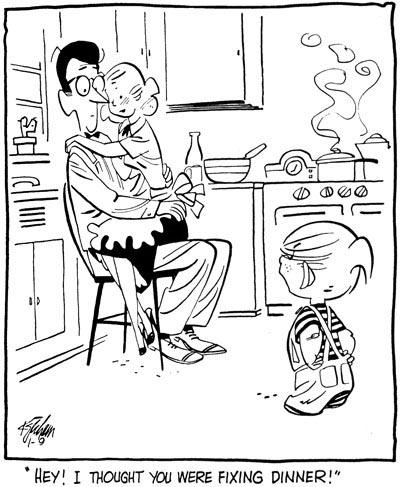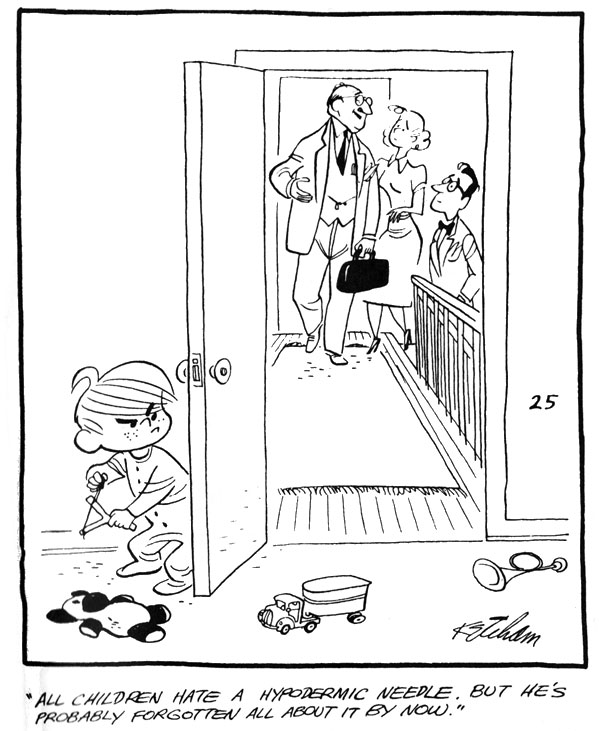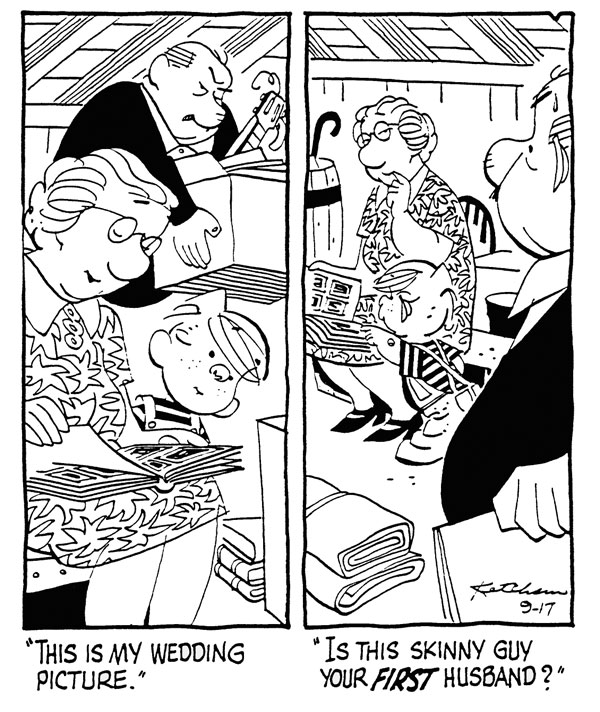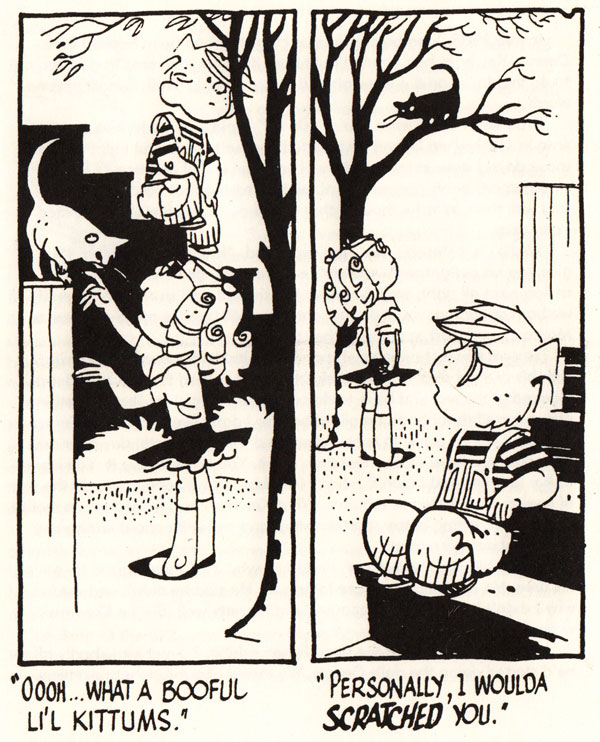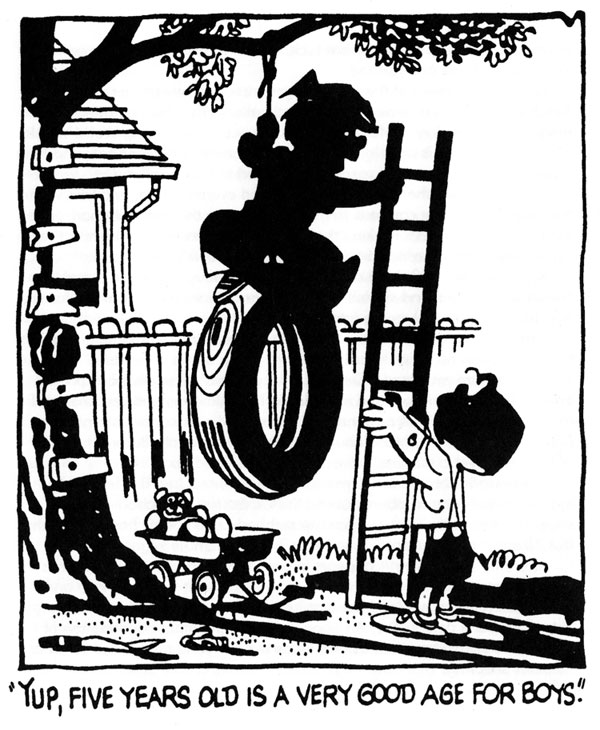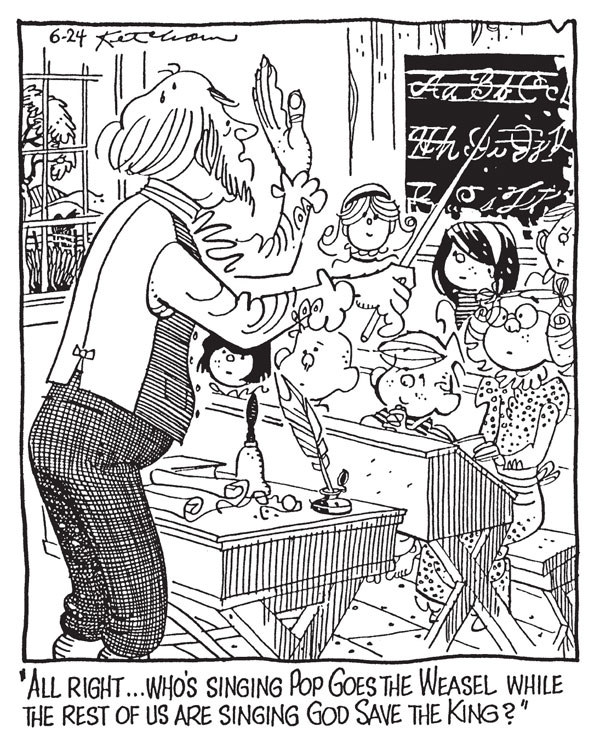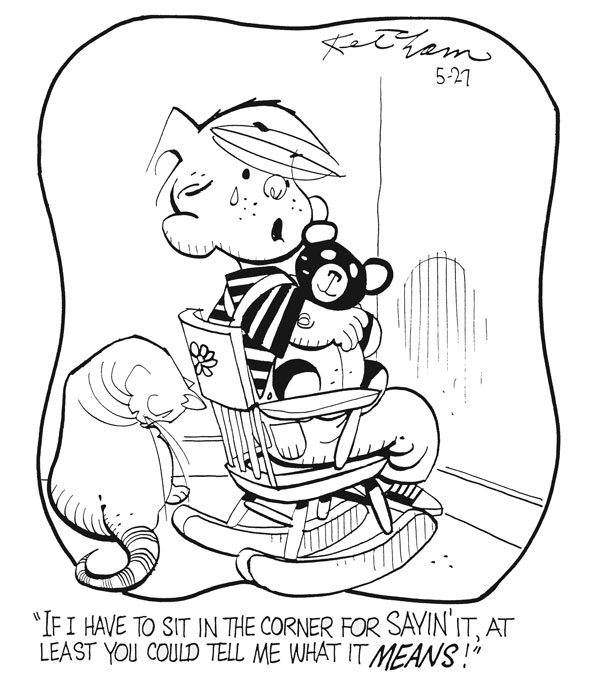'Dennis the Menace'.
Hank Ketcham was an American newspaper cartoonist, and the creator of 'Dennis the Menace' (1951- ). After stints in animation and newspaper cartooning, he took inspiration from his five-year old son to create his world-famous feature. What started as a syndicated single-panel cartoon, quickly turned into a multimedia franchise, spawning TV series, feature films, comic books and all sorts of merchandise.
Early life
Henry King Ketcham was born in 1920 in Seattle, Washington. A descendant of Revolutionary War veterans, his paternal great-grandfather James Baird Weaver had run for President of the United States twice in the late 19th century for the Greenback Labor Party, but was never elected. Hank's father Weaver V. Ketcham was a Navy officer, described by the cartoonist in his autobiography as a stern disciplinarian, but with a good sense of humor and always supportive of his son's artistic ambitions. His mother Virginia King was a talented writer, who sold short stories to magazines. She died when Hank was twelve years old, shortly after giving birth to his youngest sister.
Hank Ketcham grew up fascinated by cartoons, and enjoyed copying the cartoon features from the Seattle Times and the Seattle Post-Intelligencer. Especially Billy DeBeck's 'Barney Google', Carl Ed's 'Harold Teen', Bud Fisher's 'Mutt and Jeff', Fontaine Fox's 'The Toonerville Folks' and Sidney Smith's 'The Gumps' left a lasting impression on him. After watching the Walt Disney short 'The Three Little Pigs' (1933) he strove for a career in cartooning. As a kid, he took every art class Queen Anne High School had to offer, and impressed his classmates with his drawings. He also took a mail-order course from the W.L. Evans School of Cartooning, and learned many tips and tricks from 'Tack Knight's Cartoon Tips', a paperback book of instructions. In 1937, Ketcham enrolled at the University of Washington as an art major and drama minor, but dropped out after one year to make the grade in Hollywood.
Animation
In 1938, eighteen year-old Ketcham headed for Los Angeles, hoping to secure a job with the Walt Disney Studios. Arriving there, he was flat out refused, but thanks to his former classmate, animator Vernon Witt, he got hired by Walter Lantz instead. After fourteen months working as an inbetweener on Lantz's 'Andy Panda' shorts, he got the opportunity to work at Disney after all. Climbing the ladder to become assistant-animator, he worked directly alongside animators Bernie Wolf and David Swift in Ward Kimball and Fred Moore's unit. Among the films Ketcham animated on were the features 'Pinocchio' (1940), 'Fantasia' (1940), 'Bambi' (1942), 'Wind in the Willows' (1946) and dozens of 'Donald Duck' shorts. Ketcham later said that his Disney years formed his art training. They taught him everything on how to depict action scenes and the movement of drapery and clothing. One of his friends at his unit was future magazine cartoonist Virgil Partch, with whom he brainstormed for gag ideas in his spare time.
U.S. Navy
On 7 December 1941, the Japanese army bombed Pearl Harbor, and the United States entered World War II. Ketcham and many other animators from his unit were drafted. Feeling he was physically ill-suited for combat, he tried to enlist in the U.S. Navy. In January of the following year, he was sworn into the United States Naval Reserve as a photographer's mate third class. He was stationed at the Photo Research Lab at N.A.S. Anacostia, near Washington, D.C. Together with fellow cartoonists George Sixta and Ned White, he was mainly tasked with creating sales and training material for the War Bond program, including food conservation posters. He also initiated the development of a series of promotional cartoon shorts, starring the character 'Seaman Hook'. It brought him back to Hollywood, where the first animated cartoon, 'Take Heed, Mr. Tojo' (1943) was produced by Walter Lantz Studios and directed by James "Shamus" Culhane. Three more Ketcham-written shorts were developed by Warner Bros.: 'The Return of Mr. Hook' (1945), 'Tokyo Woes' (1945) and 'The Good Egg' (1945), directed respectively by Bob McKimson, Bob Clampett and Chuck Jones.
Gag cartoonist
His 9 to 5 daytime job for the War Bond Allotment magazines offered Ketcham enough time to do additional cartooning in the evenings. By 1944, he regularly submitted gag cartoons to magazines like Collier's, The Saturday Evening Post, True and Liberty. He also delved into commercial art, creating Sylvester, the mascot for the National Retail Lumber Dealers Association. One of Ketcham's most notable wartime creations was 'Half Hitch' (1943-1945), a small sailor on a battleship who appeared in weekly pantomime single-panel cartoons on the back pages of the Saturday Evening Post. Ketcham revived the character during the 1970s in another comic strip feature.
After the war, the young Ketcham family first settled in Westport, Connecticut and eventually in Carmel, California. Ketcham spent the first post-war years doing more magazine cartoons and commercial art assignments. He gradually improved his craft, taking advice from befriended cartoonists like Noel Sickles and Perry Barlow. At the time, Ketcham also greatly admired the New Yorker cartoonists Peter Arno, George Price, Whitney Darrow Jr., and Gluyas Williams.
Early 1951 'Dennis the Menace' cartoon.
Dennis the Menace
Ketcham's first attempt at newspaper syndication was 'Little Joe', a multi-panel gag strip about a mischievous little boy. Created shortly after the war, the feature can be considered a try-out for 'Dennis the Menace'. King Features Syndicate considered it for a couple of weeks, but finally rejected it. The idea resurfaced in October 1950, when Ketcham was working on a Saturday Evening Post cartoon, while his wife Alice checked in on their son, five-year old Dennis. Thinking he was taking a nap, she discovered he instead had trashed his room like a tornado. She stormed into her husband's studio, exclaiming the historical words: "Your son is a menace!" Ketcham quickly cranked out a set of twelve cartoons with a recurring character based on his son: 'Dennis the Menace'! The name wasn't completely unique, though. Between 31 October and 21 November 1943, Stanley J. Link had created a short-lived companion comic to his 'Tiny Tim' Sunday comic with this same name.
Ketcham submitted his ideas to the New York-based Post-Hall Syndicate, who instantly accepted the series. On 12 March 1951, 'Dennis the Menace' was launched as a daily single-panel cartoon in 16 newspapers. Coincidentally, on the very same day, a completely non-related feature with exactly the same title was launched in the United Kingdom: David Law's 'Dennis the Menace'! While Law's 'Dennis the Menace' was a vicious prankster, the mischievousness of Ketcham's Dennis is unintentional. With his childhood curiosity and energetic playfulness, Dennis creates chaos wherever he goes. Like many five-year olds, he asks the wrong questions at exactly the wrong time, embarrassing his parents in front of family members, passers-by and officers of the law. Since Dennis was based on the cartoonist's own son, his antics are never far from reality. His parents, Henry and Alice Mitchell, are spitting images of Hank and Alice Ketcham. On several occasions, the Ketcham family posed for syndicate publicity photos, dressed like their cartoon counterparts. Adding to the realism were the extensive character backgrounds and personality sketches Ketcham and his co-workers created for the feature's cast.
'Dennis the Menace'.
Besides his parents, the main victim of Dennis' "terror" is his next-door neighbor mister Wilson, a retired U.S. Postal Service worker with a sheer amount of hobbies. Dennis sees the grumpy pensioner as his best adult friend, and gladly interrupts him during his gardening, stamp collecting or other peaceful activities. Even though George Wilson rather ducks away whenever Dennis comes in sight, he secretly has a soft spot for the boy. Far more receptive to Dennis' unannounced visits is Mrs. Wilson, who treats him like the grandson she never had, spoiling him with freshly baked cookies and milk. Dennis' loyal sidekicks are Ruff, his faithful dog, and the slightly younger neighborhood kid Joey, who looks up to Dennis. The bespectacled Margaret acts as Dennis' nemesis. The bossy know-it-all secretly has a crush on him, and tries to elevate him to her own standards. She corrects his grammar, criticizes his manners and insults his scruffy dog, much to his dismay. Still, she stubbornly ignores Dennis' rebuffs, insults and putdowns. Also fancying Dennis is Gina Gillotti, an outgoing tomboy girl who accepts Dennis the way he is. Dennis likes her too, but is too young and innocent to realize he has a crush on her.
'Dennis the Menace'.
Success
The publication of 'Dennis the Menace' quickly expanded. Before the first year had ended, the syndicate distributed the daily 'Dennis the Menace' feature to about 100 newspapers. Because of the success, his editors asked Hank Ketcham to add a color Sunday comic strip to his production, launched on 13 January 1952. From the start, Ketcham hired assistants to handle this additional workload, the first team being Fred Toole (writing) and Al Wiseman (art). Toole and Wiseman were also the main creators of the 'Dennis the Menace' comic book stories, made exclusively for Pines Publications from 1953 on. Additional help during the 1950s and 1960s came from George Crenshaw, Lee Holley, Vic Lockman, Joe Messerli, Bob Paplow, Homer Provence and Owen Fitzgerald. Lynn Karp wrote scripts for several of the comic book stories.
After 31 issues at Pines, Hallden/Fawcett continued the comic book license, and released monthly issues until November 1979, ending the original run after 166 issues. Between November 1981 and November 1982, Marvel Comics published a new series of thirteen 'Dennis the Menace' comic books. By then, Bob Bugg, Frank Hill, Bill Williams, Brian Lum, Ron Ferdinand and Karen Matchette were new creators working on the production of both the Sunday feature and the comic book stories. The first paperback collection of daily strips appeared at Avon in 1952. The hardcover edition by Henry Holt & Company promptly appeared on the New York Times Best-Seller List. Many collections followed until 1983, mostly published by Fawcett, who also released the 'Dennis the Menace Pocket Full of Fun' digest line.
Mascot and merchandise
'Dennis the Menace' also spawned other activities. As early as 1952, plans were made to turn an old rubbage dump in Monterey, California into a 'Dennis the Menace' playground. Hank Ketcham personally oversaw the design in collaboration with Arch Garner, strongly emphasizing on safety. On 17 November 1956, Hank and Dennis Ketcham festively opened the site, which also housed a bronze Dennis statue sculpted by Wah Chang. From 1971 to 2001, 'Dennis the Menace' was the official mascot of Dairy Queen, appearing in commercials and on cups, bags, and other promotional items.
Adaptations
A 'Dennis the Menace' TV sitcom aired on CBS between 1959 and 1963, with Jay North as Dennis. A live-action TV movie followed in September 1987 under the title 'Dennis the Menace: Dinosaur Hunter'. In 1993, a 'Dennis the Menace' live-action feature film hit the cinemas. Title star in this box office hit was Mason Gamble, who was chosen for the role out of a reported 20,000 auditioning children. Subsequent direct-to-video releases were 'Dennis the Menace Strikes Again' (1998) and 'A Dennis the Menace Christmas' (2007). The first animation project with 'Dennis the Menace' was the 1981 TV movie 'Dennis the Menace in Mayday for Mother', produced by DePatie-Freleng. In the period 1986-1988, DIC Animation produced 78 episodes of a syndicated 'Dennis the Menace' animated TV series. Each half-hour series consisted of three six- or seven-minute episodes. Capitalizing on the live-action movie release, a new thirteen-episode series was produced in 1993 under the title 'All-New Dennis the Menace'. The animated movie 'Dennis the Menace in Cruise Control' premiered in 2002 as part of Nickelodeon's Sunday Movie Toons block. In 1993, Ocean Software developed two 'Dennis the Menace' video games, one for the Amiga and one for the Super NES, followed by a Game Boy version in 1994.
'Dennis the Menace' cartoon from the 1980s, with use of the chiaroscuro effect.
Daily panel - style
While his co-workers were tasked with the additional 'Dennis' productions, the daily panel remained Ketcham's own project. A true perfectionist, he personally drew the feature until his official retirement in 1994. With his background in animation, Ketcham's single-panel (and occasionally double-panel) cartoons maintained a sense of action and earned praise for their smooth pen-and-ink linework. His panels were known for their clever staging, effective camera angles and skilled use of texture, shading and chiaroscuro. Like many cartoonists, Ketcham regularly worked with gag writers. In his autobiography, he credited Bob Harmon for "breathing fresh humor, warmth and uniqueness into the feature during the early days." Other ghost writers for the 'Dennis' dailies were Al Batt, Norman Maurer, Jerry Bendsen, Carson Demmans, Steve Dickenson, Bob Saylor and Dana Snow.
Throughout the decades, the 'Dennis the Menace' feature remained true to its concept and settings. The only excursion in the daily feature was the 1976 'Yankee Doodle Dennis!' series of cartoons, celebrating the bicentennial of the United States. Created by Ketcham and writer Bob Saylor, the series presented the Mitchell family coping with life in New England in the days leading up to the American Revolution. In 1977, Ketcham and his team were commissioned by Word Books, Inc. to produce a series of ten comic books under the title 'Dennis and the Bible Kids', with the usual cast of characters reading and acting out the stories of Biblical characters. With its family friendly sitcom vibe, 'Dennis the Menace' has rarely been the subject of controversy. The only notable event was the late 1960s introduction of Jackson, an African-American kid. His stereotypical depiction was considered racially offensive, with protests erupting in Detroit, Little Rock, Miami and St. Louis, where rocks and bottles were thrown through the windows of the Post-Dispatch offices. Shocked by this sudden outrage, and meaning no harm, Ketcham quickly dropped the character.
Cartoon from the 1976 'Yankee Doodle Dennis!' series.
International success
The Post-Hall Syndicate (later Publishers-Hall Syndicate) continued to distribute 'Dennis the Menace' until in 1967 Field Enterprises acquired it. Nowadays, the strip is syndicated by King Features to about 1,000 newspapers in 48 countries. Ketcham's character is known all over the world, mostly as Dennis or variations of that name ('Denis', 'Danny', 'Daniel'). The syndicate even attempted to get it published beyond the Iron Curtain, sending the cartoonist on a 1960 "Humor Exchange" tour through the Soviet countries. He was warmly greeted by cartoonists from the Russian satirical magazine Krokodil, but it never came to an exchange, since political tensions between East and West intensified shortly after his visit.
Like many other American newspaper comics, the character is particularly beloved in Scandinavia. Between 1958 and 1993, Dennis had his own magazines in Sweden, published subsequently by Formatic Press/Dennis Förlag and Semic Press. To supplement its content, the Swedish publisher obtained a license to print original 'Dennis the Menace' stories, produced locally by artists like Kiki Olsen and Bertil Wilhelmsson.
The Marvel comic books also presented selections of the daily strips (Dennis The Menace #1, 1981).
Geneva years
After his trip through the USSR, Ketcham stayed in Europe, eventually settling in Geneva, Switzerland, between 1960 and 1977. In his autobiography, he called this the most rewarding period of his career on a creative level. Far from his business associates in the USA, Ketcham had all the time to work on his daily panel, in a close communication with his stateside writing partner Bob Saylor. Ketcham and Saylor also worked on a musical adaptation for 'Dennis the Menace', but it never saw the light. Besides 'Dennis', Ketcham found the time to work on additional projects during his European years. For the Canton of Geneva, he wrote and illustrated a four-page brochure under the title 'Geneva Just For Fun', widely distributed by Swissair, the Swiss Railroad and many local hotels.
Half Hitch
A notable side project was the relaunch of his wartime cartoon character 'Half Hitch' (1970-1975). With the USA entangled in the Vietnam War, Ketcham felt there were many comics about the military, but none about the Navy. He revived his sailor, added a new cast of secondary characters, turned it into a daily and Sunday comic feature, and sold it to King Features Syndicate. Since he didn't have the time to produce it himself, Herb Gochros was hired as the writer, and Dick Hodgins, Jr. took care of the art duties. The feature was launched on 16 February 1970. Unfortunately, it quickly dropped in popularity, and several papers canceled it after only six months. Re-evaluating the subject matter, Ketcham felt the strip was too gag-driven, and had no real connection to the Navy. To boost up the quality, Ketcham established contacts with the Navy, who supplied him with feedback and background information. Bob Saylor became the new writer, who managed to continue 'Half Hitch' with Hodgins for five years. However, the damage was already done, and 'Half Hitch' never regained its lost clientele, and was canceled in 1975.
'Half Hitch' daily from 1973, drawn by Dick Hodgins.
Recognition
Hank Ketcham received the Reuben Award (1953) for his 'Dennis the Menace' strip. The city of Wichita, Kansas made him honorary mayor, since the 'Dennis' cartoons take place in one of the city suburbs. For the golden anniversary of 'Dennis the Menace' in 2001, Brian Walker curated an exposition of Hank Ketcham's art at the International Museum of Cartoon Art in Boca Raton, Florida.
Final years and death
Hank Ketcham continued the daily feature in his Pebble Beach house studio until 1994, and then left it to his successor Marcus Hamilton. Ron Ferdinand has been the official artist of the Sunday comic since 1981. Ketcham spent his final years painting in oil and watercolor. Many of his paintings can be seen in a hospital in nearby Monterey. He also wrote his memoirs, released as 'The Merchant of Dennis the Menace' (1990, reprinted in 2005 by Fantagraphics Books). The veteran cartoonist remained involved as a creative consultant for his strip. Suffering from heart disease and cancer, Hank Ketcham passed away peacefully on 2 June 2001, at the age of 81. Since 2010, the 'Dennis the Menace' franchise is overseen by the cartoonist's youngest son Scott Ketcham (b. 1977), a former storyboard artist for TV shows, who is actively involved in the writing, editing and inking too.
Personal tragedies
While the cartoon Dennis shall always remain an innocent "five-ana-half", the life of the real Dennis Ketcham took a more tragic turn. His parents separated when he was twelve years old. His mother Alice succumbed to a dependency on barbiturates and alcohol, and passed away of a brain hemorrhage on 22 June 1959. When his father moved to Geneva with his second wife, Dennis was in a Connecticut boarding school. He later served in Vietnam, where he suffered post-traumatic stress disorder. Hank and Dennis Ketcham were estranged for much of Dennis' adult life.
'Dennis the Menace'.
Legacy and influence
With its worldwide audience, Hank Ketcham's 'Dennis the Menace' has been an influence on slice-of-life family comics around the globe. In the States, former assistant Lee Holley created a similar feature with the teenage girl 'Ponytail' (1960-1988). Harry Mace's feature about the obnoxious 'Amy' (1960-1991) is in many ways a female copy of Dennis. To compete with the 'Dennis the Menace' comic books, Archie Comics launched the similar 'Pat the Brat' series (1955-1959). Among the creators involved in this carbon copy were Leon Winik, Bob Bolling, Joe Edwards and Ray Osrin. In Europe, Ketcham's influence can be felt in Jean Roba's family gag comic 'Boule et Bill', with the main star sharing his messy hair and trademark dungarees with Dennis. When the Swedish publisher Formatic Press lost the rights to 'Dennis the Menace' in the late 1960s, artist Kiki Olsen was tasked to create a replacement, resulting in the similar kid comic 'Peo' (1970-1983). Spanish comic artist Javier Pont drew a family comic titled 'Laurín y sus Papás de Pillo a Pillo', of which the cast members were obviously modeled after Dennis' family. In the United States, Bill Wray also cited Ketcham as an influence, while in Canada John Kricfalusi is an admirer.
In Matt Groening's editorial 'The Hitherto Untold Secret Origin of a Certain Spiky-Haired Cartoon Character', printed in Simpsons Comics issue #20 (May 1996), he recalled watching the 1959-1963 TV sitcom of 'Dennis the Menace' as a boy. Unaware that it was based on a newspaper comic, the five-year old Groening was excited by the prospect of a TV show about "a kid who was a menace". Much to his disappointment it turned out to be just another bland family sitcom. In the BBC documentary 'My Wasted Life' (2000), he recalled that the child actor didn't even use his slingshot. Decades later, when Groening created Bart Simpson in his animated TV series 'The Simpsons', he specifically designed Bart as an actual menace, as opposed to Dennis. In the episode 'Take My Wife, Sleaze' (1999), Jay North, the actor who played Dennis in the old 'Dennis the Menace' TV sitcom, was a special guest voice, failing to impress Bart with the lame "menacing" antics he performed in the show.



